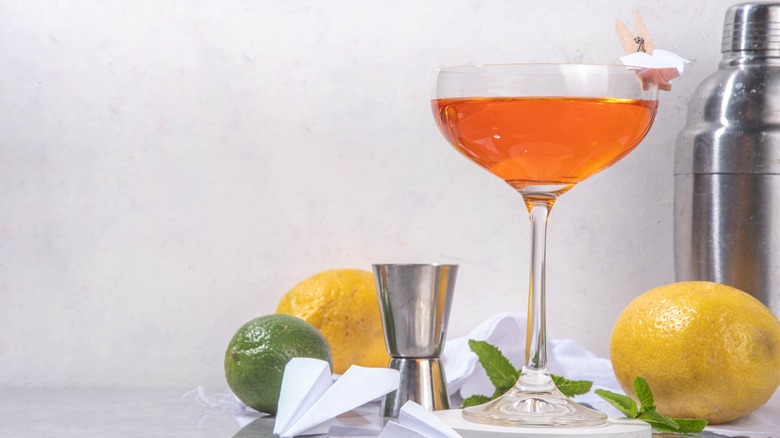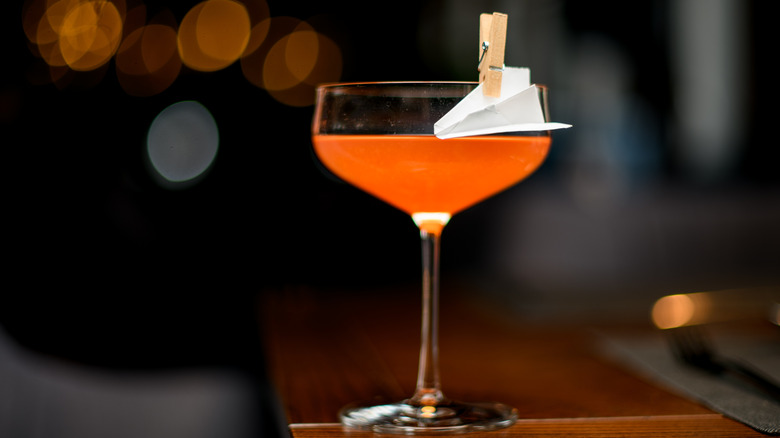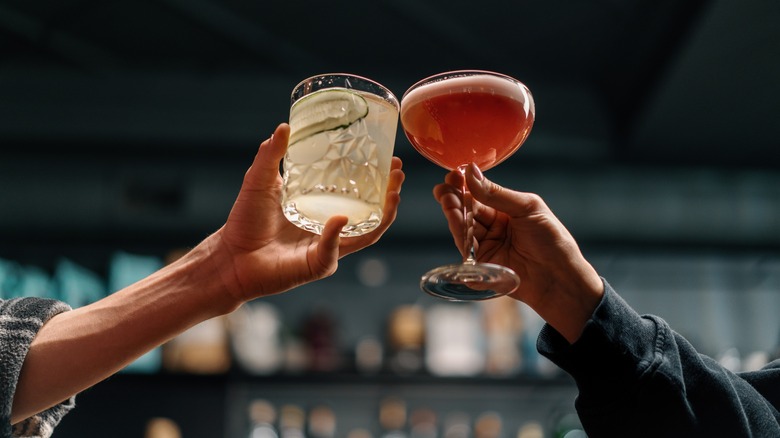The Paper Plane Cocktail Was Named After A Classic Pop Song
The world of cocktails is constantly changing. New, innovative drinks are developed every day, and while some trends come and go, others are destined to become classics, those that will still be chic to drink 50 years from now because they are delicious, perfectly balanced, and beautiful to behold. The Paper Plane just might fall into the latter category. Based in bourbon, which is experiencing a burst of trendiness, it is a masterful combination of bitter, tangy, and herbal flavor notes. The name itself, though, gives no indication of what's in the drink. With a name like Paper Plane, one might expect it to be sky-blue in color, or perhaps a variation of the Aviation cocktail, but it's actually a rusty orange color and a spin on a drink called Last Word.
The creator of the drink happened to be listening to M.I.A.'s 2008 hit "Paper Planes" on repeat while he was making the new cocktail and, thus, named it accordingly. Despite the presence of bourbon, a Paper Plane is unmistakably Italian in attitude, as it contains both Aperol (of Aperol Spritz fame) and a grappa-based amaro called Amaro Nonino, both of which give the drink its bitter edge. To brighten it up, fresh lemon juice is included, and everything is served straight up after being shaken with ice until nicely chilled.
Who created the Paper Plane?
Sam Ross is an award-winning bartender and co-owner of New York City cocktail lounge Attaboy, which was formerly called Milk & Honey. He is a master mixologist, but doesn't spend all his time behind the bar. The native Australian also conducts classes on cocktail creation and builds programs for other bars. It was during one of these times that the idea for the Paper Plane came to him. While building a drink menu for a bar in Chicago in 2008, Ross looked to the Last Word for inspiration, which is traditionally made with gin, lime juice, green Chartreuse, and maraschino liqueur.
Combining bourbon, lemon juice, Amaro Nonino, and Campari, he found the drink a little too bitter and replaced the Campari with Aperol, all while swaying to the beat of "Paper Planes" playing in the background. In a nod to the name, he garnished each glass with a tiny paper airplane and guests loved it. Ross took the concept back to New York with him and, not surprisingly, residents of the Big Apple also found the cocktail to be delicious.
Paper Planes couldn't be easier to create; they contain equal parts of all four ingredients (typically ¾ ounce of each) moderately shaken over ice, just until cold. Over-shaking the concoction could result in a watery drink.
Flight change
Even though the Paper Plane was created in the 21st century, it has an unequivocally old-school feel, no doubt due to the use of bitter liqueurs and edgy bourbon. Since its inception, crafty bartenders and cocktail enthusiasts have developed several variations of the drink (many of them with mile-high names), which could be seen as the best form of flattery. The Winglet, for example, is made with bourbon, Aperol, lemon juice, and orange juice, with a touch of grenadine in the bottom of the glass.
An Airport Bar combines all of the ingredients of a Paper Plane except the Amaro, adding strawberry liqueur instead. When you substitute rum for the bourbon, you get what's called a Paper Kamikaze; and a First Officer Spritz includes everything but the Amaro, plus the drink is topped with soda water (which people naturally love) for a nice bubbly lift (off).
For traditional Paper Planes, any kind of amaro will do, in fact, you'll get a slightly different flavor profile with different types. Even using bitters will work when you're in a pinch. Try sipping one to the song it was inspired by.


